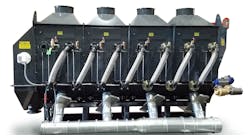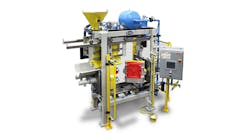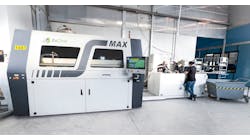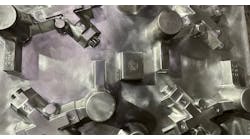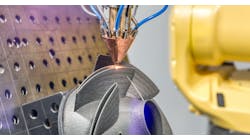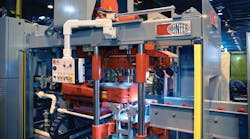Most foundries regard their molding operations the way many car lovers regard their rides: they’re loyal to the brand that first won their favor. In that way, it was not surprising when Progressive Foundry in Perry, IA, installed a Hunter Foundry Machinery’s new HLM Series machine: it has been operating Hunter molding and mold handling machinery for over 30 years. But the installation still counts as a breakthrough, the first installation of Hunter’s HLM Series.
Progressive Foundry pours gray and ductile iron castings, from just a few ounces to more than 100 lb. (as the designs require), for short runs or series production programs. It’s a full-spectrum metalcasting operation too, with extensive sand handling, coremaking, test and metallurgical labs, and beyond the molding sequence it performs grinding and finishing.
Hunter — the firm credited with one of the great innovations in sand mold production, the matchplate process — unveiled the HLM Series in the spring of 2013, and it was an innovation in its own right: “For the first time in our industry, the new HLM Series combines and integrates magnetically coupled rodless cylinders and linear bearings for movements of the squeeze platen, cope flask, sand measuring hopper and other components on the machine,” the system developer and patent-holder, Hunter Foundry Machinery president and CEO Bill Hunter detailed at that time.
In previous matchplate designs, the machines’ working parts (cam followers, wheels, tracks, rails, and other mechanisms) were subjected to the typical conditions of a sand molding process as well as to the high operating rates and the forces involved in handling, forming, and releasing finished molds.
In contrast, Bill Hunter explained, “The HLM offers sealed linear motion slides and magnetic rodless cylinders to replace these older components, providing smoother, quieter and more energy efficient operation with less maintenance and greater machine stability.”
Even so, metalcasters like Progressive Foundry value matchplate molding for its high flexibility for mold volumes and dimensions, and its high throughput rate. Over the decades, Progressive had installed four Hunter molding machines (two HMP-20Hs, one HMP-10C, one XL 2024), as well as four Hunter mold-handling systems for pouring and cooling.
An HLM-10 machine replaced the HMP-10 C series automatic molding machine, which had been operating for over 30 years. Having made its first appearance in April 2013, the HLM Series’ first installation took place in July of that year, as Progressive Foundry conducted a scheduled shutdown.
The new machine, with a 14×19-in. flask, was not selected only as replacement molding capacity: the non-closing operation as well as the detached hydraulic power system make for cleaner production, with easier maintenance.
According to Progressive Foundry production superintendent Steve Wilkening, another important factor in the selection is the HLM-10’s magnetic (not hydraulic) components. “There are no board-feed hydraulics, they’re all magnetic. I like that aspect. I like the slow mold close, and we like the fact that we’ve eliminated the slippers,” he said.
The HLM-10 machine uses the Hunter HLH molding systems that are in service for the other Hunter molding machines. And, it occupies the same footprint, and the same push-out height, as the Hunter C-series automatic molding machine it replaced. Its sand receiver and board return are interchangeable with the previous machine, too.
However, Wilkening noted that there has been a significant improvement in mold quality in the transition from the C series to the HLM. “We have seen no shift and crush, since we’ve had the machine. Also, mold hardness is up around 90 to 92, which we couldn’t get previously.”
“It was the easiest to install of all the new machines we put in,” according to Progressive Foundry president Pete Van Kirk. “The operation was as smooth as it was before, and we were making molds, good molds (800 total) the second day out.”
Since the success at Progressive Foundry, the HLM series found a welcome reception in North America, and this year it made its debut on the international scene at GIFA 2015. According to Bill Hunter the reception from the (international) market was excellent, notably in terms of the inquiries from interested contacts. “In fact, we may say that we have registered the interest from a more ‘mature’ market that already knows Hunter in general, and understood the features of the new machine.”
Hunter added that foundries already operating previous generations of the firm’s automatic molding machines confirmed that the new functions and capabilities introduced with the HLM series match their current operational needs.
Having noted that, Bill Hunter also said that there are different operating considerations for newer molding machines, according to a foundry’s market. He noted that, in general, there are markets where demand for new machinery is based on a need to modernize existing plants, to gain more efficiency and better finished-product quality. In other markets, the value of the capital investment (while still aiming for technical proficiency) is a more decisive factor. The president/CEO expressed confidence that the HLM series will be well received in either case.
Competitiveness is a Global Concern
Another molding development at GIFA 2015 was the decision by a Dutch manufacturer, Royal Lovink Industries to contract DISA Group to install the new DISA 270-A vertical molding line at its iron foundry in Terborg, The Netherlands. “The DISA partnership helps us to stay competitive long-term and increase our market share due to continuous implementation and improvement of new technology. By replacing old with new, we succeed in enabling Lovink to perform better and more, thereby expanding our business,” according to Dirk Jan van den Hout, co-owner and managing director.
The foundry, Lovink Technocast, operates DISA technology and molding lines, as well as lost foam and hand molding.
Since the early 1970s, Lovink has been producing molds on Disamatic 2070 and 2032 lines. The new vertical molding line is an investment intended to improve its competitive position, as well as overall product quality and production flexibility.
“With this new investment, our aim is to clearly emphasize our long-term strategy to serve customers in a variety of industries where the required flexibility, lead-time and quality are ever increasing factors. The improved accuracy of the new DISA 270-A will not only improve the quality of our products; being equipped with a fast and fully automatic pattern plate changer, it also will enable us to enhance flexibility and time-to-market. We feel convinced that the more efficient production processes based on a higher quantity of molds per hour as well as the improved accuracy will help us stay competitive in the very high demanding markets in which we operate,” stated co-owner/managing director Alexander van den Hout.
The foundry operators believe the DISA systems’ world-class design and state-of-the-art process equipment will be an effective combination.
“Having decided to replace the Disamatic 2070 molding line with the latest technology of the DISA 270-A, we expect to achieve performance improvements that include faster production in molds per hour, higher production up time, as well as a reduced casting mismatch, which remains a major cost driver,” Dirk Jan van den Hout said. “Even with our smaller batches, we want to see if we can better alternate our business, and the DISA equipment and technology is what supports our ability to deliver aesthetic perfection to customers throughout the world, such as some of the major appliances brands.”
“The future is all about customer contact and having the right people,” Alexander van den Hout offered. “The foundry industry has a tendency to continuously target more complex parts, and obviously we also need to alternate our working processes with intelligent systems in future.”
While he conceded there would be challenges in terms of material and technology, customer partnerships will remain a critical element of competitiveness. “We not only work with our customers; we engineer with them,” Alexander van den Hout said. “And, the time-to-market, flexibility and reliability gained through listening to, talking to and interacting with customers is what will allow us to have the valuable process knowledge needed to make all the necessary changes happen.”




